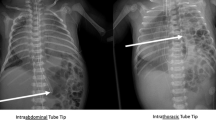Abstract
Background
Neonates with congenital diaphragmatic hernia (CDH) often require placement of lines and tubes for supportive therapy. The resulting altered anatomy can result in diagnostic errors when interpreting the location of support lines and tubes such as UVCs (umbilical venous catheters).
Objective
The purpose of this study was to evaluate the effect of CDH on UVC position and to evaluate the accuracy at which radiologists describe the position on chest radiographs.
Materials and methods
During a 5-year period, 406 chest radiographs performed within 7 days of birth in infants with congenital diaphragmatic hernia were identified and reviewed for the following data: presence of UVC, location of catheter tip (cavoatrial junction, intracardiac, intrahepatic or umbilical vein), and location of CDH (right or left). The radiologic report of the UVC tip location for each case was then reviewed individually to determine the adequacy of interpretation. Inadequate reports were classified as incorrect (the wrong location of the catheter tip was reported), no mention (the location of the catheter tip was in a suboptimal location but not mentioned), and not specified (the precise location of the catheter tip was not clearly stated in the report when the tip was in a suboptimal location).
Results
A total of 60 infants were identified as having CDH (56 on the left, 4 on the right). The most common location for an incorrectly placed UVC was the contralateral chest, accounting for 26.7% (16/60) of the infants, followed by an abdominal intrahepatic location (16.7%) and the umbilical vein (8.3%). Thirty percent (120/406) of the chest radiograph reports were found to be inadequate regarding the interpretation of the location of the catheter tip. The majority of the inadequate reports (48/406, 11.8%) did not specify when the catheter tip was in a suboptimal location. In 37 reports (9.1%), the location of the catheter tip was reported incorrectly, and no mention of the catheter location was made in 35 reports (8.6%).
Conclusion
The location of an UVC in an infant with Bochdalek hernia can pose a diagnostic challenge because of the altered anatomy and change in the expected course of the catheter. Familiarity with the altered anatomy and vigilance of the various abnormal locations in which UVCs can be placed can help optimize management for the child and reduce morbidity and mortality.












Similar content being viewed by others
References
Sharma S, Jain R, Singh MK et al (2007) A case of congenital diaphragmatic hernia with a hernia sac attached to the liver: hints for an early embryological insult. J Pediatr Surg 42:1761–1763
Raisanen P, Cassel I, Martin G et al (2010) UVC complication in an infant with left-side congenital diaphragmatic hernia: extravasation owing to hepatic vein catheterization. J Pediatr Surg 45:e33–e35
MacGillivray TE, Jennings RW, Rudolph AM et al (1994) Vascular changes with in utero correction of diaphragmatic hernia. J Pediatr Surg 29:992–996
Sakurai M, Donnelly LF, Klosterman LA et al (2000) Congenital diaphragmatic hernia in neonates: variations in umbilical catheter and enteric tube position. Radiology 216:112–116
Wigger HJ, Bransilver BR, Blanc WA (1970) Thromboses due to catheterization in infants and children. J Pediatr 76:1–11
Simeunovic E, Arnold M, Sidler D et al (2009) Liver abscess in neonates. Pediatr Surg Int 25:153–156
Yigiter M, Arda IS, Hicsonmez A (2008) Hepatic laceration because of malpositioning of the umbilical vein catheter: case report and literature review. J Pediatr Surg 43:E39–E41
Yeh J, Vargas JH, Wozniak LJ et al (2014) Massive liver mass and parenteral nutrition extravasation secondary to UVC complications. J Clin Neonatol 3:158–160
Bothur-Nowacka J, Czech-Kowalska J, Gruszfeld D et al (2011) Complications of umbilical vein catherisation. Case report. Pol J Radiol 76:70
Egyepong J, Jain A, Chow P et al (2011) Parenteral nutrition—ascites with acute renal failure as a complication from an umbilical venous catheter in an extremely low birth weight infant. BMJ Case Rep. doi:10.1136/bcr.02.2011.3813
Kim JH, Lee YS, Kim SH et al (2001) Does umbilical vein catheterization lead to portal venous thrombosis? Prospective US evaluation in 100 neonates. Radiology 219:645–650
Fuentealba I, Taylor GA (2012) Diagnostic errors with inserted tubes, lines and catheters in children. Pediatr Radiol 42:1305–1315
Conflicts of interest
None
Author information
Authors and Affiliations
Corresponding author
Rights and permissions
About this article
Cite this article
Chang, P.T., Taylor, G.A. Umbilical venous catheter malposition and errors in interpretation in newborns with Bochdalek hernia. Pediatr Radiol 45, 982–988 (2015). https://doi.org/10.1007/s00247-014-3275-7
Received:
Revised:
Accepted:
Published:
Issue Date:
DOI: https://doi.org/10.1007/s00247-014-3275-7




